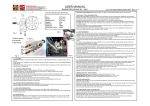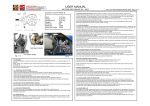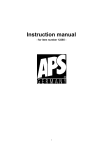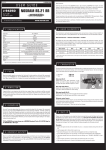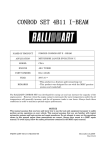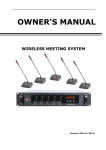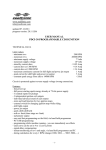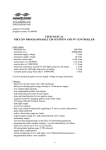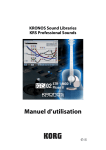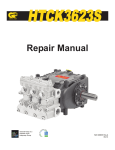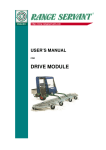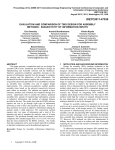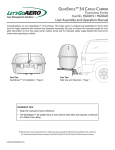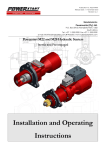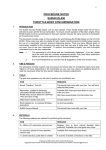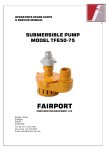Download Marzo 2011 - Eshop
Transcript
NOVAROSSI WORLD S.R.L. Via Tel. Europa, 20/a – 25040 Monticelli Brusati (BS) Italy Tel. (+39) 030.6850316 – Fax (+39) 030.6850314 Web: www.novarossi.com – E-mail: [email protected] Codice fiscale/Partite IVA 02812810980 WARNING - ATTENTION BEFORE USING THIS ENGINE PLEASE CAREFULLY READ THIS INSTRUCTION HANDBOOK. . SAFETY RULES – This product is not a toy but a competition engine. It can be dangerous and it can cause damages if the present safety rules are not followed and the instructions specified in this workbook. In particolar: - This engine cannot be used under 14 years of age; - The engine must not be started before having blocked it with 4 fixing screws on the model as explained on the manufacturer hand book; - Do not manipulate or modify the engine in order to avoid eventual dangerous situations. Use it only with suitable pipes. Novarossi World S.r.l. does not guarantee the safety level of operating certified by the marking if any modification/manipulation is made on the engine itself. - Only high quality radio controls and components must be used in order to assure a perfect and sure control of the model. In particular the propeller must be of very high quality to minimize risk of breakage and unpredictable damages. - The engine must be used only for model purposes. For a complete list of safety rules see point “safety instructions”. 0) INTRODUCTION. 4) RUNNING-IN. Novarossi World S.r.l. engines are the result of an extensive technological research into materials, of high precision CNC working and of 55 years of experience in the model field. These instructions have been prepared: - to obtain the best performances from the engines guaranteeing them longer life; - to prevent mistaken maintenance before, during and after the use from generating damages to the engine; - to guarantee a high safety level of use of the engine. Novarossi World S.r.l. suggests to setting up engines and makes a good running in so the whole mechanical sliding parts be settled and polished The carburetor is set at the factory and it only needs adjustments to control the base and full speed needle to get the best carburetion. a) Car – Fix the engine on the car and run it in at low rpm for at least 30 minutes; b) Plane – Fix the engine on the plane (or test bench after fitting a propeller to the crankshaft) and run it at low rpm for at least 30 minutes. c) Helicopter – See sheet attached (User Manual) Attention – It is necessary to pay attention to all moving parts. d) Boat – Fix the engine on the boat and run it in the water at low rpm for at least 30 minutes. The first time you run the engine, let it run for about 30 minutes at 15.000-20.000 rpm. The longer is the running in period, the better the engine will adjust itself and will perform at this at its highest level during competitions. 1) WARRANTY AND RESPONNSIBILITY. The warranty covers eventual manufacturing shortage (material) but does not cover damages due to wrong or non correct use which does not correspond to the specifications required at the order of the item. See indications given and limitations specified at point 9 of this workbook. Any attempt manipulation or particular modification will cause spontaneously the guarantee decay time. 2) IDENTIFICATION OF THE ENGINE: DESCRIPTION AND TECHNICAL DATA. In the engine box you will find following documents: - Identification sheet of the product: includes batch number of the engine. This number is fundamental to track back the production date of the engine and must always be transmitted in case of assistance requirement; - Exploded design of engine and its carburetor: Include an exploded design of all spare parts which are part of the engine and carburetor and their referring part numbers to order spare parts or eventual optional parts. - Factory carburettors settings Novarossi World reserves the right to modify products without prior notice. 3) CONNECTIONS–IGNITION STARTING AND BLOWING OUT. 3.1 CONNECTIONS. Must be made properly following the instructions given by the model manufacturer. 1st Connect the manifold and the pipe to the tank; 2nd connect the fuel tube to the carburetor; 3rd connect the uniball of the carburetor to the servo control; 4th connect the drive shaft to the model clutches and/or propellers. 3.2 IGNITION AND STARTING. 1st Connect the glowplug to the specific device connected with a battery at 1.2Max 1,5 Volt; 2nd Accelerate by radio-control after you have opened a quarter of carburetor; 3rd Make the engine flywheel run in counter clock-wise direction according to the model. Car version – Put the model on the starting box where an electric motor through a rubber wheel transmits the starting to the engine. Plane version – The model must be put on a safety stand through an electric motor on which terminal part there is a rubber spinner. The starting is transmitted to the shaft spinner connected with the engine. Attention – Please be careful to all moving parts. Marine version – The ignition and starting system could be different: it could be like car or plane version (see following point), Helicopter version – See sheet attached (User Manual) Attention - Be careful; never reach over near rotating parts. 3.3 BLOWING OUT. Stop the engine by closing the needle valve thru the remote radio control or use a rag to cover the exhaust tip. Be careful! The exhaust is extremely hot so make sure you are using a thicker rag. Be aware rag is not covering the air filter, dirty could be pushed inside the motor. Attention – Never stop the fly wheel by using your hand 5) WHICH TYPE OF FUEL MUST BE USED. You must use high quality fuel because good fuel allows good performances and long life to the engine. In our opinion the best lubricant is castrol oil (sale code 1N1) which prevents overheating and assists the lubrication of all moving parts such as bearings, pin of shaft, pistons and sleeves. Small quantities of synthetic oils are allowed (sale code 1T2). Composition of fuel for running: 14% ungummed castrol oil (first pressure acidity lower than 0.5) or 7% castrol oil + 7% synthetic oil + 80% pure methanol + 6% nitro. Note= For Plane: 10% nitro + 10% castrol oil + 10% synthetic oil + 70% pure methanol • Be aware that the compression Ration engine setup must be used to run the content type based on the following data: outside ambient temperature 59/77°F & altitude between 500 and 1000 meters Please follow the below mentioned step to optimize your engine in case of temperature fluctuations: - In a case of the temperature increase, add 0.05 / 0.1 mm head shim. - When temperature of ambient decrease, engine must be subjected to a compression so remove 0,05/0,1mm head shim Be also aware of the variation at your pressure altitude: 0,05/0,1 mm decompression with increasing altitude Composition fuel after the running : 1/8 ON ROAD / RALLY-GT: SHIM UNDERHEAD STANDARD: See exploded in closure 25% nitro + 6% castrol oil + 4% synthetic oil + 65% pure methanol 1/10 TOURING: See exploded in closure 16% nitro + 6% castrol oil + 4% synthetic oil + 74% pure methanol 1/8 OFF ROAD: See exploded in closure 25% nitro / 3% castrol oil / 7% synthetic oil / 65% pure methanol 33% nitro / 3% castrol oil / 7% synthetic oil / 57% pure methanol MARINE: See exploded in closure 25-30% nitro / 6% castrol oil / 4% synthetic oil / 60-65% pure methanol PLANE: See exploded in closure 10% nitro / 10% castrol oil / 10% synthetic oil / 70% pure methanol HELICOPTER: See sheet attached (User Manual) 6) BEST RUNNING-IN CONDITIONS FOR THE ENGINE. 8) SAFETY INSTRUCTIONS. It is very important be able to wisely dose the acceleration of the engine so to make the pipe resonating as quietly as possible avoiding useless skidding to the model; very often engines break before starting due to sharp accelerations and to the driver’s frenzy. Sharp acceleration causes te skidding of the balls of the ball bearing into their sliding guides and consequent wear. NOTE – Novarossi World S.r.l. has been cooperating with the major worldwide companies specialized in the production of micro ball bearings, obtaining the best quality. Many indications referring the right and safe use of the engine have been supplied in this workbook. In this chapter we resume and complete them with other ones pointing out that the user is the only responsible for a safe conduct towards himself, third parties, animals and locations. Being the engine part of a complex model which can potentially be dangerous, it must be started up after having checked the model responses to the most important safety requirements. This check must be made by the manufacturer of the model and assured by the presence of logo on the product. 8.1 Everybody who can be damaged by the model (above all children) must be kept away from the operator and from the model. Spectators must always respect safety distances. 8.2 The engine must be carefully fixed on the model. Attention to the heat developed the noise is reduced thanks to a silenced pipe. You cannot start the engine without this pipe. 8.3 The pipe and size of the propellers and blades, must be suitable to the engine and to the model and must be of high quality. Ask to the manufacturer of the models for detailed information and for installation ways. 8.4 When you start the engine you must keep your face body and hands away from moving parts (propellers, gears, wheels,…). Do not touch the engine: there could be very high temperatures. 8.5 All adjustments must be made using instruments (screw drivers) of correct dimensions. 8.6 You must use a radio control and components of high quality, this allows a perfect control of the engine (acceleration and stop). 8.7 Pay attention to electric lines. 8.8 Use safety glasses and gloves anytime you are working in the presence of propellers. 8.9 Propeller can cut but must be dangerous for many other reasons such as: - on sandy soil: propeller can blow sands in the eyes; - ties, pens and other hanging objects could be attracted by the propeller. Even when the engine is blown out, for the helicopter, the blades go on moving for some time. Be careful. 8.10 Keep fuel in a suitable and sure place. 8.11 Follow with care the safety rules given by different federations, basing on category and use of model. 8.12 Ask always to shops for any requirements or information or to point out any anomalies. 7) MAINTENANCE/CLEANING/CONSERVATION OF THE ENGINE. 7.1 MAINTENANCE OF THE ENGINE AFTER USE. Before the engine is put away after the use, we recommend the following procedure. 1st Ensure no fuel remains inside the engine: disconnect the fuel feed line (using a clip or a tape), pay attention no fuel remains inside the engine. This is very important in order to prevent oxidation and rusting inside the engine, if fuel is left inside the engine for any length of time, it will create an acidic solution containing alcohol, water and nitro which will heavily ruin the engine. The conrods for instance, will turn a lead color and the shaft and bearings will be dark in color in the affected areas.Attention – Please be careful to all moving parts. 2nd Outside cleaning of the engine. For this you should use petrol mixed with 5-10% lubrication oil and a small brush to remove sludge. Attention – You must precede when the engine is blown out and cold to avoid contact with moving parts or dangerous high temperatures. 3rd Inside cleaning of the engine. The same mixture can be used to clean the inside of the engine but before doing this remembers to remove the air filter, the glowplug and the rear cover. Place the piston in the top dead center (PMS) before removing the rear cover. If you don’t follow this advice you could break the piston against the groove. 9) CONCLUSION – WARRANTY RESTRICTIONS Do not clean the silicone tuned crankshaft with solvent or gasoline. Attention – You must precede when the engine is blown out and cold to avoid contact with moving parts or dangerous high temperatures. We recommend to use the following anti-dust back cover (cod. 29064 2,1cc/2,5cc – cod. 29065 3,5cc/4,66cc)on your crankcase, carburetor and fuel intake. A very important procedure to make the engine properly run is air filter cleaning which should be done as following: 1st take out the air filter; 2nd wash it with petrol mixture mixed with 10% of oil; 3rd blow from inside to outside to eject all the collected dirt; 4th recoat it with a special Novarossi oil (sale code 30021); 5th fix again the air filter on the carburettor, ensuring that the retention band is firmly fixed. A correct maintenance of the air filter avoids dust sucking in the engine which is very dangerous for the engine itself. 7.2 PROTECTION OF THE ENGINE. Dust – Sand. Dust and sand can cause engine wear. Most of all on piston (which wears), ball bearing, on shaft (which scratches on the aspiration area), on the pin of the shaft (which can become smaller of 0.10mm on the Ø). With the pin in these conditions you run the risk to break the conrod.In order to avoid this kind of problem you should carefully and correctly maintain the air filter. Rust –Oxidation. Rust and oxidation can be avoided using a good quality fuel. Alcohol can contain a high percentage of water or it can absorb it from the atmosphere being it hygroscopic if the tank is open. Nitro is not of first quality as well very often. If you note oxidation in your engine, we strongly suggest you stop using your present nitro and run the engine using only a mixture of alcohol and oil. Good fuel is composed of alcohol without water, good nitro and ungummed castrol oil of first pressure (acidy lower than 0.5%). Parts mostly exposed to oxidation and rust due to bad fuel are: ball bearing, shaft and conrod. Attention – Do not drink fuel or its components and do not inhale fumes. Overheating. Overheating can be avoided not using a tool lean mixture (with a too low percentage of oil), also paying attention that the fuel speed needle is not too closed. Overheating the engine can cause increase of temperature of the shaft, turning its pin in blue color. That means that it reaches 200° Celsius. With the shaft also the conrod overheats over 180° Celsius, losing its mechanic characteristic. In this case we suggest replacing them. Generally when the piston has been exposed to overheating it will size near the exhaust and the sleeve will no longer be usable. Overheating can also lead to failure of the piston and the combustion chamber. Overdrive. Many of the causes of overdrive are due to failures of the gear, clutch or radio control. In this case the rear cover should always be removed to check for any damage of the pin and crankshaft, which could get excessive play, if this has happened you must replace these parts. Novarossi World S.r.l. will always try to use the best materials available to maintain the high quality and reliability of products. We reserve the right to make changes without notice. No warranty is given for damaged ball bearings, conrods and couplings installed on the engine. In fact ball bearing can be ruined by rust and oxidation, caused by the use of bad quality alcohol. Conrods break for sudden leanings by bad lubrication for incorrect working of gear box due to over drive happened also in a previous moment and, above all, for the use of improper fuel. The same damaging causes to the conrod may cause an irreparable ruin of the sleeve due to the high temperature reached. Novarossi World does not guarantee the wear of the pin of the shaft caused by dust which comes into the engine. To avoid this trouble we suggest you use air filters (sale code 30001 off road / sale code 30002 on road). In any case we cannot replace under guarantee any engines or spare parts which after examination present manipulation of one of the defaults above listed. GLOW PLUGS FOR AMBIENT TEMPERATURE °C :


